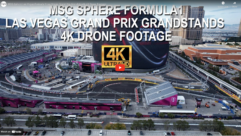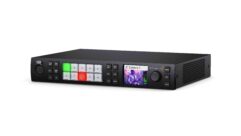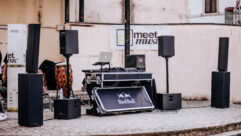
Behind the Scenes with Stage Tec: Producing Live Multisite Operas, Part 1
Nov 9, 2010 11:27 AM,
With Bennett Liles
Listen to the Podcasts
|
Editor’s note: For your convenience, this transcription of the podcast includes timestamps. If you are listening to the podcast and reading its accompanying transcription, you can use the timestamps to jump to any part of the audio podcast by simply dragging the slider on the podcast to the time indicated in the transcription.
Related Links

Behind the Scenes with Stage Tec: Producing Live Multisite Operas, Part 2
Taking opera to the streets, Stage Tec and Swiss TV took up the challenge with
Aida on the Rhine
and Christian Fuchs of Stage Tec was right in the middle of the production manning an RS digital mixing console….
Producing an opera on live TV would be a big enough job in a theater with everything on the same stage and just changing locations just by flying in another backdrop, but taking it to the streets with multiple location performances takes it to a new dimension. Christian Fuchs of Stage Tec is here to tell us how he and the Swiss TV crew pulled off the live production of Aida on the Rhine coming up next on the SVC podcast.
SVC: Christian, it’s great to have you with me here on the SVC podcast all the way from Germany, and the time difference was a little bit of a challenge, but we got that worked out. First off, tell me a little bit about Stage Tec; what does the company do and how long has it been around?
Stage Tec is manufacturing high-end digital audio routers and digital mixing consoles since 1993 now. The company started in 1993 with the Nexus system as an only audio routing system. They developed the famous True-Match conversion technology, and one year later, they came out with the first Cantus console, which was all over the year a big success. And most of these Cantus consoles are still running in the news, and now we still support it of course, but our flagship now is the Aurus console. [Timestamp: 1:43]
Right, the Aurus Direct Access mixing console developed from the ground up by Stage Tec. How does Stage Tec get into this opera project done in the city of Basel, Switzerland? It was certainly not your first opera production.
The show was Aida at the Rhine River, so the opera was produced in a hotel and an area around the Rhine River. And we became involved because the Swiss TV is mainly using Stage Tec equipment in their studios, OB trucks, main switching rooms, and this since really many years now. And whenever they have huge productions like sometimes happens in winter time as well, especially in winter sports, they start renting from our company. We are not a rental company in the normal meaning, but customers of us can rent systems from us to extend their systems if needed. [Timestamp: 2:42]
And the idea of this type of production sounds almost like a live news cast is begun with a series of reporters doing live shots from all over town and monitoring the sound from the central location. How did the idea of taking the opera production to the streets of the city come about rather than having it all on stage in a theater?
That was a few years ago. [It was] the idea of a theater director, and he had the idea to bring the opera to where the people live and work and not bring the people to the opera. And the first TV show like that—also live TV broadcasts was already—two years ago, that was the opera La Traviata, and that took place in the main train station of Zurich during the normal day business. And last year it was the opera La Bohème in Switzerland, and it took place in a shopping mall, an apartment house, and a market place. So the Aida opera this year was the third broadcast and recording of that, and it is amazing to be a part of this show and to see how it works, and there is always a lot of audience around even so that they don’t really advertise this production. [Timestamp: 4:03]
Well, obviously, by going on remote with an opera they’re not choosing the easiest way to do it, but it is certainly taking out to a much wider audience. I would think, though, that the audio monitoring for the performers would be an especially challenging situation.
It was a challenging situation because on all three opera productions, the area was quite big and the scene of the spots where the different scenes took place were quite far from each other so it was a big deal for the in-ear sides to make sure that the RF signal can be received wherever it was needed. For the big crowds like the ensemble or also for the audience there was a FM transmitter in town with 50W so everyone was able to listen with a standard radio on 88.2MHz to the whole production. [Timestamp: 5:00]
OK, going RF with the monitoring from a central transmitter just like the local news casts do would make it a lot easier and a lot less time-consuming to set up. So for sound monitoring, rather than using open speakers, they were going with in-ear monitoring for the performers; that’s a lot of RF going both ways. Who handled all of that?
We had great support from Sennheiser itself, Mr. Klaus Wilhelmsen. They were responsible for all of the RF issues coming up, and they solved it really perfect that both directions of transmission worked really proper on the receiver side for the microphones with no dropouts at all and on the receiver side for the in-ear with just tiny little dropouts on different spots but all the principals, which got in-ear monitoring for individual monitoring, were really happy with it. [Timestamp: 5:55]
1
Behind the Scenes with Stage Tec: Producing Live Multisite Operas, Part 1
Nov 9, 2010 11:27 AM,
With Bennett Liles
That would simplify things going in-ear for the performers rather than trying to deal with some kind of a mixed minus signal through open speakers. Although, I have seen that done. The in-ear monitoring would really make a difference.
Yeah, it worked really great with in-ear systems. [Timestamp: 6:10]
And you were right in the middle of it working hands-on. What was your specific role in the production?
I was actually rented with the Aurus console. They needed to set up a third studio, and my job was to premix all the vocalists so all of the principal singers got two wireless microphones, but they were coming through different receivers. I had for every principal between four and 12 receiver channels coming in, and there were three rehearsals where I had to take the time to write down notes in the music book and program cues for this to make sure that on every scene or even sometimes just for a few bars, I had to change a singer from one receiver to the other and back that there’s audio with no interruption or weird noise starting or something like that on it, and finally I sent it out seven mixes to the OB truck that was doing the final opera mix and also to the multitrack recording and monitor mixer. [Timestamp: 7:24]
OK, and all that went over a Nexus network?
That was all done over the Nexus network. Also all communication devices were all running through the Nexus system, the commentator systems as well, and we had no issue in latency or things because for every step through the Nexus, we talk about one sample latency and then you just have to add a very short time for AD/DA conversion. [Timestamp: 7:55]
And of course that’s all on fiber-optic lines.
All the Nexus is connected on fiber-optic cable, which we can run in multimode up to 1.5km and in single-mode, we can go up to 100 to 120km. [Timestamp: 8:13]
Did you have to lay all the fiber cable just for this event or was there any of it useable already in place?
Nothing useable in place; one reason for that was that, of course, OB trucks, they have standardized fiber-optic connectors and for Swiss TV, it’s usually easier to run and lay the own fiber cables. So a standard length at Swiss TV is a 5km wheel with fiber cable on it. So all the cabling was laid from Swiss TV for the whole production. [Timestamp: 8:48]
And I mentioned earlier that this was all done in the town of Basel, Switzerland. Did you have any particular challenges as far as following local codes and regulations, traffic control, and things like that?
For sure you have some challenges on a production like that, the location of the hotel itself. All the surrounding has got very narrow roads, so that was the first challenge—that there was not really enough space for all the trucks unload in and unload out. The two OB trucks were really standing on the sidewalks, so they had to block the sidewalks for people walking by and no street was closed. The public transportation was still running even during the opera production—of course these are challenges all. There was a huge Spidercam across the Rhine River, and they had to put the cable wheels for the Spidercam they brought in with helicopters to put them on the roof of the buildings. [Timestamp: 9:51]
And you actually had some of the scenes staged in boats out on the Rhine River?
Yeah, there were scenes on the Rhine River on a boat. For that, they had a coal transportation boat, which was packed with people and this was all citizens from Basil. They cast it a few days before with citizens from Basil just to pack this boat, and this boat was coming up the Rhine River while Radames was singing and that was quite one of the biggest distances we had to make sure that audio was working all over the place. [Timestamp: 10:27]
Well moving along the river that would certainly call for a lot of two-way wireless links.
Yeah, absolutely.
Well, Christian, it’s been great having you here for part one of the Aida on the Rhine opera production, and in part two we’ll get into the details of the RF mics and the spectrum used and how the mix for 5.1 sound was done, but thanks for being here for part one.
Yeah, I appreciate it; thank you.
2










